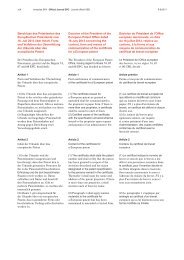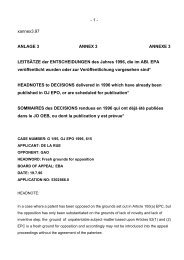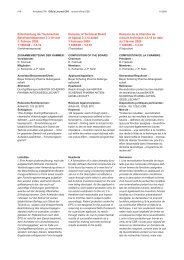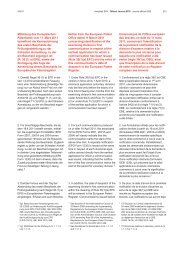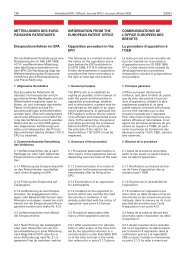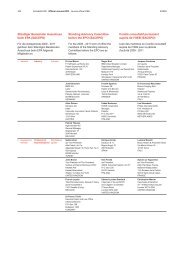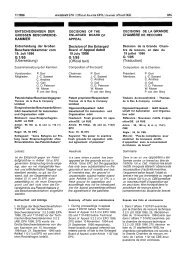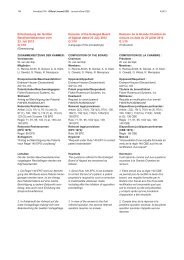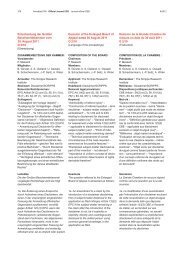Sonderausgabe 1 - European Patent Office
Sonderausgabe 1 - European Patent Office
Sonderausgabe 1 - European Patent Office
Create successful ePaper yourself
Turn your PDF publications into a flip-book with our unique Google optimized e-Paper software.
2007 <strong>Sonderausgabe</strong> Nr. 1 ABl. EPA / Special edition No. 1 OJ EPO / Edition spéciale n° 1 JO OEB 45<br />
(2) Für den Zeitraum bis zur Erteilung<br />
des europäischen <strong>Patent</strong>s wird der<br />
Schutzbereich der europäischen <strong>Patent</strong>anmeldung<br />
durch die in der veröffentlichten<br />
Anmeldung enthaltenen <strong>Patent</strong>ansprüche<br />
bestimmt. Jedoch bestimmt<br />
das europäische <strong>Patent</strong> in seiner<br />
erteilten oder im Einspruchs, Beschränkungs<br />
oder Nichtigkeitsverfahren geänderten<br />
Fassung rückwirkend den<br />
Schutzbereich der Anmeldung, soweit<br />
deren Schutzbereich nicht erweitert wird.<br />
Artikel 70<br />
Verbindliche Fassung einer europäischen<br />
<strong>Patent</strong>anmeldung oder eines<br />
europäischen <strong>Patent</strong>s<br />
(1) Der Wortlaut einer europäischen<br />
<strong>Patent</strong>anmeldung oder eines europäischen<br />
<strong>Patent</strong>s in der Verfahrenssprache<br />
stellt in Verfahren vor dem Europäischen<br />
<strong>Patent</strong>amt sowie in jedem Vertragsstaat<br />
die verbindliche Fassung dar.<br />
(2) Ist die europäische <strong>Patent</strong>anmeldung<br />
jedoch in einer Sprache eingereicht<br />
worden, die nicht Amtssprache des<br />
Europäischen <strong>Patent</strong>amts ist, so ist<br />
dieser Text die ursprünglich eingereichte<br />
Fassung der Anmeldung im Sinne<br />
dieses Übereinkommens.<br />
(3) Jeder Vertragsstaat kann vorsehen,<br />
dass in diesem Staat eine von ihm nach<br />
diesem Übereinkommen vorgeschriebene<br />
Übersetzung in einer seiner Amtssprachen<br />
für den Fall maßgebend ist,<br />
dass der Schutzbereich der europäischen<br />
<strong>Patent</strong>anmeldung oder des europäischen<br />
<strong>Patent</strong>s in der Sprache der<br />
Übersetzung enger ist als der Schutzbereich<br />
in der Verfahrenssprache; dies<br />
gilt nicht für Nichtigkeitsverfahren.<br />
(4) Jeder Vertragsstaat, der eine<br />
Vorschrift nach Absatz 3 erlässt,<br />
a) muss dem Anmelder oder <strong>Patent</strong>inhaber<br />
gestatten, eine berichtigte Übersetzung<br />
der europäischen <strong>Patent</strong>anmeldung<br />
oder des europäischen <strong>Patent</strong>s<br />
einzureichen. Die berichtigte Übersetzung<br />
hat erst dann rechtliche Wirkung,<br />
wenn die von dem Vertragsstaat in<br />
entsprechender Anwendung der<br />
Artikel 65 Absatz 2 oder Artikel 67<br />
Absatz 3 aufgestellten Voraussetzungen<br />
erfüllt sind;<br />
(2) For the period up to grant of the<br />
<strong>European</strong> patent, the extent of the<br />
protection conferred by the <strong>European</strong><br />
patent application shall be determined<br />
by the claims contained in the application<br />
as published. However, the<br />
<strong>European</strong> patent as granted or as<br />
amended in opposition, limitation or<br />
revocation proceedings shall determine<br />
retroactively the protection conferred<br />
by the application, in so far as such<br />
protection is not thereby extended.<br />
Article 70<br />
Authentic text of a <strong>European</strong> patent<br />
application or <strong>European</strong> patent<br />
(1) The text of a <strong>European</strong> patent application<br />
or a <strong>European</strong> patent in the<br />
language of the proceedings shall be the<br />
authentic text in any proceedings before<br />
the <strong>European</strong> <strong>Patent</strong> <strong>Office</strong> and in any<br />
Contracting State.<br />
(2) If, however, the <strong>European</strong> patent<br />
application has been filed in a language<br />
which is not an official language of the<br />
<strong>European</strong> <strong>Patent</strong> <strong>Office</strong>, that text shall<br />
be the application as filed within the<br />
meaning of this Convention.<br />
(3) Any Contracting State may provide<br />
that a translation into one of its official<br />
languages, as prescribed by it according<br />
to this Convention, shall in that State be<br />
regarded as authentic, except for revocation<br />
proceedings, in the event of the<br />
<strong>European</strong> patent application or <strong>European</strong><br />
patent in the language of the<br />
translation conferring protection which is<br />
narrower than that conferred by it in the<br />
language of the proceedings.<br />
(4) Any Contracting State which adopts<br />
a provision under paragraph 3:<br />
(a) shall allow the applicant for or<br />
proprietor of the patent to file a corrected<br />
translation of the <strong>European</strong> patent application<br />
or <strong>European</strong> patent. Such<br />
corrected translation shall not have any<br />
legal effect until any conditions established<br />
by the Contracting State under<br />
Article 65, paragraph 2, or Article 67,<br />
paragraph 3, have been complied with;<br />
(2) Pour la période allant jusqu’à ladélivrance<br />
du brevet européen, l’étendue de<br />
la protection conférée par la demande<br />
de brevet européen est déterminée par<br />
les revendications contenues dans la<br />
demande telle que publiée. Toutefois, le<br />
brevet européen tel que délivré ou tel<br />
que modifié au cours de la procédure<br />
d’opposition, de limitation ou de nullité<br />
détermine rétroactivement la protection<br />
conférée par la demande, pour autant<br />
que cette protection ne soit pas étendue.<br />
Article 70<br />
Texte de la demande de brevet européen<br />
ou du brevet européen faisant foi<br />
(1) Le texte de la demande de brevet<br />
européen ou du brevet européen rédigé<br />
dans la langue de la procédure est le<br />
texte qui fait foi dans toutes les procédures<br />
devant l’<strong>Office</strong> européen des<br />
brevets et dans tous les Etats contractants.<br />
(2) Toutefois, si la demande de brevet<br />
européen a été déposée dans une<br />
langue qui n’est pas une langue officielle<br />
de l’<strong>Office</strong> européen des brevets, ce<br />
texte constitue la demande telle qu’elle a<br />
été déposée, au sens de la présente<br />
convention.<br />
(3) Tout Etat contractant peut prévoir<br />
qu’une traduction dans une de ses<br />
langues officielles, prescrite par cet Etat<br />
en vertu de la présente convention, est<br />
considérée dans cet Etat comme étant<br />
le texte qui fait foi, hormis les cas<br />
d’actions en nullité, si la demande de<br />
brevet européen ou le brevet européen<br />
dans la langue de la traduction confère<br />
une protection moins étendue que celle<br />
conférée par ladite demande ou par ledit<br />
brevet dans la langue de la procédure.<br />
(4) Tout Etat contractant qui arrête une<br />
disposition en application du paragraphe<br />
3,<br />
a) doit permettre au demandeur ou au<br />
titulaire du brevet de produire une<br />
traduction révisée de la demande de<br />
brevet européen ou du brevet européen.<br />
Cette traduction révisée n’a pasd’effet<br />
juridique aussi longtemps que les conditions<br />
fixées par l’Etat contractant en<br />
application de l’article 65, paragraphe 2,<br />
ou de l’article 67, paragraphe 3, n’ont<br />
pas été remplies ;



